Local health departments (LHDs) in Utah have the authority to post health advisories and close water bodies. LHDs use recreational health thresholds established by the Utah Department of Health and Human Services (DHHS) to determine if and when a bloom presents a human health risk. The Division of Water Quality (DWQ) supports LHDs through a monitoring and sampling program that prioritizes waters that are at risk for cyanobacteria blooms, experience high recreational use, or serve as drinking water sources. DWQ interprets and reports sampling results, and along with DHHS, makes recommendations to LHDs on the issuance of recreational health advisories based on sampling data and the best available science.
Utah’s recreational health advisory guidance for HABs was last updated in 2023. It is based largely on guidance from the Environmental Protection Agency (EPA). In 2019 the EPA provided guidance on adverse human health effects from recreational exposure to two cyanotoxins: microcystin and cylindrospermopsin. Utah’s guidance also integrates the latest scientific information on the health impacts of toxigenic cyanobacteria cell count densities and a third cyanotoxin, anatoxin-a.
What can trigger a Harmful Algal Bloom Advisory?
Utah’s HAB Guidance uses four independent indicators to protect recreational users. If any of these indicators is exceeded, a recreational health advisory is recommended:
| Warning Advisory Avoid primary contact recreation (e.g., swimming, waterskiing, wading) | Danger Advisory Stay away from the waterbody |
|---|---|
| Over 100,000 cells/mL of HABs | |
| Over 8 μg/L of microcystins | Over 2000 μg/L of microcystins |
| Over 15 μg/L of cylindrospermopsin or anatoxin-a | Over 90 μg/L of anatoxin-a |
| Over 8 μg/L of saxitoxin | Over 75 μg/L of saxitoxin |
| Under a Warning Advisory there is potential for short-term effects (e.g., rash, nausea, vomiting, diarrhea) or long-term illness | Under a Danger Advisory there is potential for short-term effects, long-term illness, or death |
Latest Guidance Documents
- Utah Department of Health and Human Services/Utah Department of Environmental Quality HAB Guidance Summary
- Recommended HAB Advisory Thresholds
When should an advisory be issued and/or a water body closed?

DHHS and DEQ recommend that LHDs use the table and accompanying decision algorithm when determining the appropriate level of health risk and public health action for a given waterbody. If a LHD receives reports of human or animal illness or death that is plausibly linked to cyanobacteria, an immediate public health advisory is recommended.
Other Harmful Algal Bloom Guidance
The recommended standard operating procedure (SOP) for collecting samples for HABs and HAB cyanotoxins are described in DWQ’s Standard Operating Procedure for the collection of Phytoplankton Samples during Harmful Algal Blooms. View the video overview, How to Sample for Harmful Algal Blooms.
The recommended SOP for collecting samples for carcasses of fish and wildlife associated with a HAB event is described in the U.S. Fish and Wildlife Service (FWS) and DWQ Guidance for Fish and Wildlife Mortality Sampling.
The recommended SOP for preparation and deployment of SPATT (Solid Phase Adsorption Toxin Testing) bags is described in the Standard Operating Procedure for Solid Phase Adsorption Toxin Testing (SPATT) Assemblage and Extraction of HAB Toxins publication.

